Today's guest post is from my colleague and good friend, Dr. Dave Tilley. Dave works over at Mike Reinold's Champion PT in Boston and has carved out a niche in the world of elite gymnastics. He inspired me to take my #CashPT practice into my daughter's gymnastics facility and now I screen and treat their athletes weekly. Thanks for letting me share Dave!
Over the last year I have been teaching, writing, learning, sharing blogs, and talking more with a lot of people in the gymnastics world. I try my best to be very transparent with people who follow my work, explaining as much as I can and offering all of the resources/literature that fuel my ideas. Through all of my communications with people I have noticed that there have been a handful of my ideas that seem to be getting really misunderstood. Although I am really happy more conversation is happening about newer thoughts for gymnastics training, I want to make sure that I clear the air on a few things. Here are 5 commonly misunderstood concepts about my work, and what I want people to understand.
1. Back Bending Skills and Splits Are “Bad For Gymnasts”
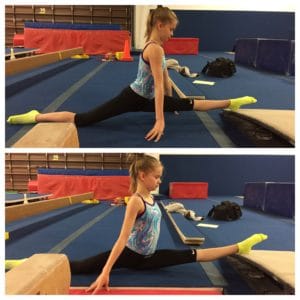
I hear this from a lot of people when I travel to lecture and teach, and I want to make sure people understand my thoughts. I don’t think either of these things are inherently dangerous for gymnasts. Quite the contrary, I think properly training hyper extension skills (bridges, walkovers / handsprings, etc) and splits is very necessary to obtain high levels of gymnastics performance. With proper training and dosage, I actually think stressing the tissues and allowing recovery creates a protective effect for the athlete. (See last weeks post for more information)
I feel the problems related to training hyper extension skills come up more in the methods used in practice. I think we get concerns related to lower back injuries when we
- don’t fully understand the anatomy and science behind why someone can / can not do a bridge (proper shoulder/hip mobility, building core control against high force, strength and conditioning)
- do not teach gymnasts from a very young age proper extension patterns. Rather than just looking at skill completion, we have to not encourage only lower back extension but more the use of their hips, lower back, upper back, and shoulders equally with good control
- do not train basic core control just as much as higher threshold core strength/power
- lose track of how many hyper extension skills are done per day, week, and month
- do not fully consider tissue load to tissue recovery ratios, which leads overtraining and overuse injury
In relation to splits, I think the problem comes up in how we obtain more hip mobility and apply it to getting new skills. I feel hip injuries and limited progress in flexibility occur when we
- do not consider gaining flexibility from further stretching already hyper mobile ligaments/joint capsules (what we don’t want) compared to increasing muscular soft tissue flexibility (what we do want)
- do not use anatomy and scientific principles to guide what stretching exercises we apply, and instead blindly apply exercises to entire groups of athletes
- only use passive flexibility methods without adding full range control, strength, and dynamic stability
- do not take time for individualized assessments and programs for athletes
- are not open to working with other professionals in the medical or strength fields
I like to use the analogy of how good coaches wouldn’t try to teach a gymnast a new skill simply by doing the whole skills 100’s of times. Most people agree that you need to break down the skill into pieces, have the athlete perfect the shapes/progressions, and make sure that the athlete is strong enough to tolerate the forces. I use the same approach to bridges and splits. A bridge or split is a pattern, similar to a skill, that has a lot of pieces to it. I feel gymnastics has to be better about reverse engineering fundamentals such as bridge and splits into individual components based off of anatomy and scientific principles.
2. We Should Abandon All The “Old School” Gymnastics Training Methods
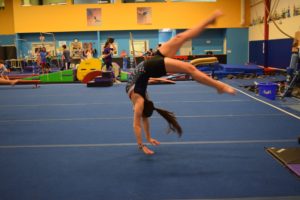
This one is most definitely incorrect. People have to realize my goal is to help introduce newer ideas, research based information, injury concepts, and practical application to training. This is to help athletes perform better and stay healthier for as long as they wish to train in gymnastics. I strive to keep learning more myself while also helping the next generation of our sport (coaches, athletes, medical providers). Readers often see my newer thoughts on the blog over the last 3 years, but forget that before I started SHIFT I had been coaching for 10 years. I learned to coach in a very traditional setting learning from older coaches/camps. Through this I picked up a ton of invaluable information from great coaches across the country, much of which I still used daily. Everything in training does not have to be supported by research or have exact science to use. Although I promote some newer concepts and feel there are areas of gymnastics we may want to change, I still very much believe in many traditional training concepts.
I am very fortunate that my work and traveling allows me to attend events like Make It Right Elite Camp. It gives me an opportunity to learn from very knowledgeable national level coaches like Neil Resnick, Mihai Brestyan, Tammy Biggs, Ivan Ivanov, Tammy and Sorin Salcianu, and many more who produce many elite level gymnasts. Every time I watch them give a clinic or lecture, I learn a ton and it helps me generate new ideas. I think by having professional discussion, being open minded, and checking our egos at the door we can blend the benefits of older and newer training concepts. I strongly feel this can lead to a gymnasts that perform at a higher level with less collateral injury damage.
3. I Only Use Weights For Strength and Conditioning
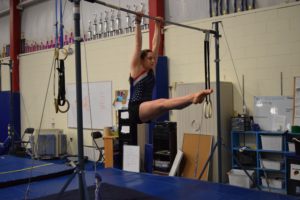
Very closely related to point number 2, I’m surprised by how many follows of my work think I only use weight lifting for our gymnasts. People see articles I write or videos I put on social media, not realizing that as with most things it is only a small glimpse of what goes on. The first thing to remember is that using external load varies significantly based on the time of year, the training phase goal, level of athlete experience, and goals of the gymnast. Within that, when I write strength programs there are a ton of body weight based drills, and gymnastics specific conditioning (ropes, presses/stalders, handstands, etc) we do daily.
There are clear benefits for gymnastics to use formal strength principles, external loading, and strength coaches. I think we are seeing more gymnastics programs not believe myths associated with external loading, but we still have a ways to go. That being said even with the addition of these newer strength training ideas, we absolutely can never abandon body weight gymnastics specific strength. It is vital to training gymnastics and making sure athletes stay safe when training skills. As noted above, the key is to blend the two areas together based on team collaboration and ongoing education.
4. I Don’t Believe in Hard Training and Injuries Shouldn’t Happen
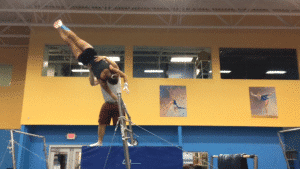
Given that I am a medical provider and write a lot on injury prevention, I certainly don’t think that this means we should not train hard. As I wrote about last week, some very interesting research has outlined some theories that under training athletes may also increase injury risks and reduce performance, just like over training. Also, readers have to remember I competed 18 years in the sport myself going up through level 10 and a college program. I realize that gymnastics (and any sport at a high level) is going to come with aches, pains, and some inevitable injuries along the way.
I do not feel, however, that gymnastics being hard gives anyone the right to not think critically about their training design and long term health of their athletes. This does not mean we can’t make a dent in the huge overuse and re-injury rates gymnastics has. I feel there is a lot of room for improvement in gymnastics related to coaches education on common injuries, medical providers knowledge of the sport, and how gymnasts can better take care of themselves. Everyone has a role to play, but I am fully an advocate for pushing gymnasts to train for high levels so long that is always has the athletes health as a priority.
5. My Information Only Applies To High Level Female Gymnasts
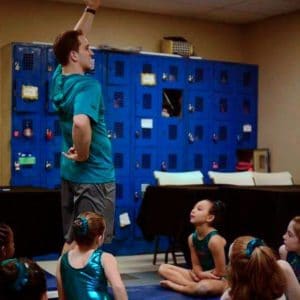
This is not as common, but does seem to be coming up more as my information is spreading. I have coached in a variety of levels and ages, for both male and female gymnastics. Although I treat a huge range of gymnastics patients for injuries, I only coach female gymnastics currently. This naturally creates content centered around what I see on a daily basis. I am trying to diversify the type of information I put out through SHIFT, but readers should understand the best way to use the information is by applying the principles of my work.
I try my best to offer the concepts that base why I do certain things in training, and then offer some practical examples, in an effort to help apply the ideas to training for everyone. Every gym, team, program, and level of gymnastics is different depending on what gym you go to. Certain ways we approach training in our gym may not be feasible or practical for others, just like there is a lot from other gyms that I know won’t make sense for our facility. I feel the best approach for people is to be open minded reading content, seek out more resources for themselves, and then work with a team to see what fits well.
Concluding Thoughts
So that is all for now, I hope that this post helped clear up some misunderstandings that seem to be going around about my work with SHIFT. As always, I thank everyone who helps make the website continue to grow and become more widespread in gymnastics. I’m looking forward to this year, as I have some new educational products being released that I feel will really help people out. Back to more new content in posts to come. Take care,
Interested in live cases where I apply this approach and integrate it with pain science, manual therapy, repeated motions, IASTM, with emphasis on patient education? Check out Modern Manual Therapy!
Keeping it Eclectic...













Post a Comment
Post a Comment